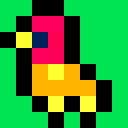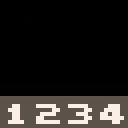I am doing a little project here and decided to show how the results are going.
The project will be called pico 4 and will run on pico 8. It will have an audio editor (16 audios, eaach one with a length of 8 notes, 16 notes and 16 volumes), a sprite editor (4 colors palette, 16 sprites, 4x4 pixels and a 32x32 screen), a map editor (32x32 tiles) and a code editor (256 tokens, each one fitting on exactly 1 byte). In the end you get 961 bytes in a cartridge and with a little 63 bytes of save (mainly for highscores) it results in 1 kilo byte cartidges.
The objective is to do a mini-console where you can do a minigame in les than 2 hours.
Will be possible to use it in any pico 8 port using of virtual keyboards and some type of external saving (thinking in some type of special qr code or something).
And every editor will be written on the bto language (successive letters of asm) the language I am ending now.
Here the first interpreter. (You need to put the code inside the cart code (last lines inside quotes) 'cause I didn't end the code editor yet lol)
I will keep updating here.
BTO DOUCMENTATION
Sintax:
Examples:

Sorry if wrote something wrong, I am not native and don't have time to correct everything lol

@biteco8, I am ... questioning ... how you are going to get 8-audio channels out of Pico-8 albeit Pico-4 when its own limitations are set to 4 - and you mentioned it would be coded in Pico-8 ?

Sorry, I wanted to say that one audio will have a length of 8 notes. Editing...

Also, I'm ending this interpreter, will be interactive in some hours...

In that case, @biteco8, I welcome your submission here with eager anticipation ! There have only been a few interpreters written for Pico-8 and outside of Brain-F they have all been pretty complex to code in.
Here is a gold star to encourage you further.

Thanks!
The interpreter itself is finished, was very simple to be true. I waste all the time I was on school today thinking on how to do it the simpler as possible. It's just a lot of words and numbers in sequence, rarely an equal sign or parenthesis. The point now is doing all the functions it needs, but I will discover them while code somethings in that language. For now, I'm ending the virtual keyboard for typing without using the dev kit

Hi @biteco8:
Yes, I don't believe a cellphone keyboard appears with Pico-8. You will either have to do joystick or rely on stat(31) for input.
I recommend you make it simple if you can. I've always had idea of simple programming languages.
If you understand BASIC, you could have these commands that could be selectable by arrow keys and 🅾️ and ❎ and custom menu:
LET, PRINT/USING/;/, , INPUT, IF/THEN/ELSE/ELSEIF/ENDIF, FOR/STEP/NEXT, CLS, GOTO, GOSUB, RETURN, END.
You can load/save 256-bytes instantly or load/save up to 12288 bytes with a 1-second "busy" animation instilled by Pico-8 when you load/save more than 256-bytes.
If you need help, let me or others know. We're all in this together.

Lol, I ended the virtual keyboard now. I just think that it can work 'cause you will use just 256 tokens, meaning a 20 minutes coding session. I'm working on a backspace system for the code editor, written in bto. The reason I didn't want to use the dev kit was to run the console in every platform: mobile, handhelds, pc etc. I'm reconsidering it but I will mantain it for now because I show my games to my friends in the mobile most times.

You've got me really anticipating this thing, @biteco8. Hope to see a release soon - and ability to write code in it ...

Lol, it almost there. We have the (almost) code editor and the interpreter, just need to put the things together. If you really want to try, load the id and change the last string to have your code there
[Please log in to post a comment]








